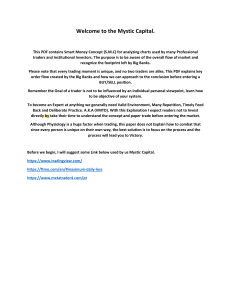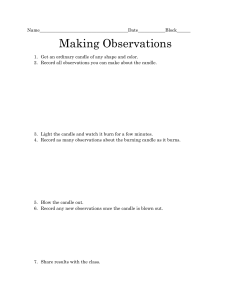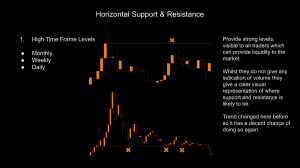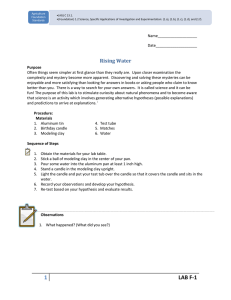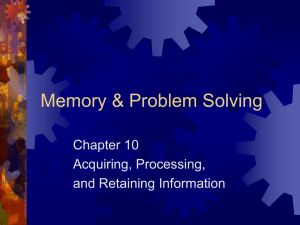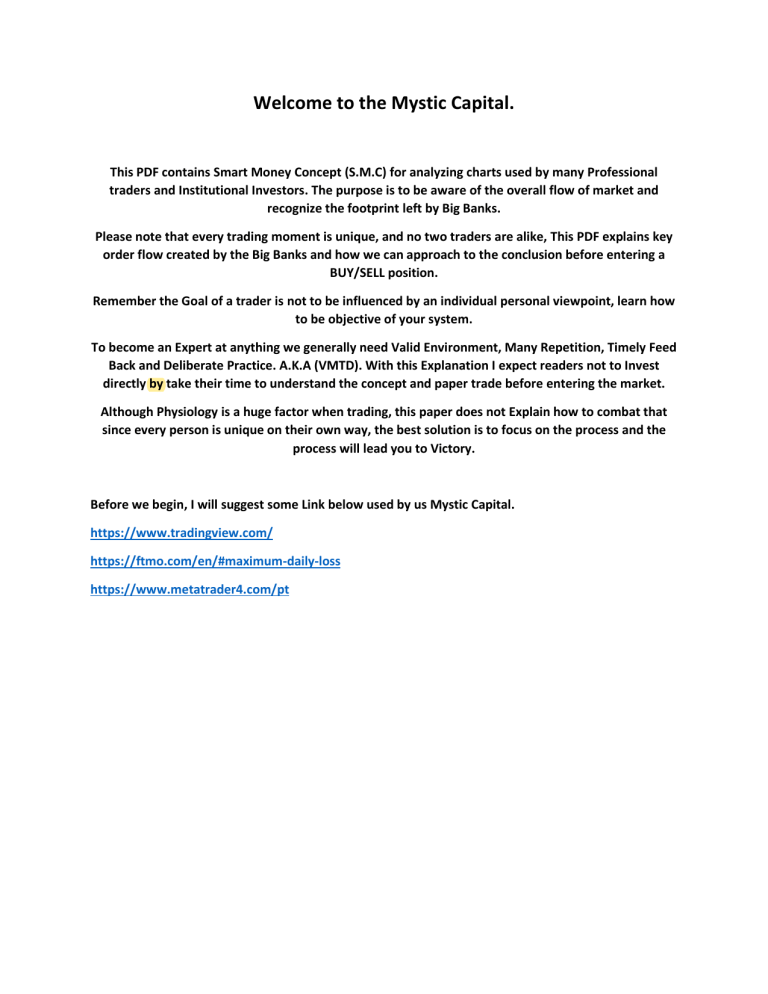
Welcome to the Mystic Capital. This PDF contains Smart Money Concept (S.M.C) for analyzing charts used by many Professional traders and Institutional Investors. The purpose is to be aware of the overall flow of market and recognize the footprint left by Big Banks. Please note that every trading moment is unique, and no two traders are alike, This PDF explains key order flow created by the Big Banks and how we can approach to the conclusion before entering a BUY/SELL position. Remember the Goal of a trader is not to be influenced by an individual personal viewpoint, learn how to be objective of your system. To become an Expert at anything we generally need Valid Environment, Many Repetition, Timely Feed Back and Deliberate Practice. A.K.A (VMTD). With this Explanation I expect readers not to Invest directly by take their time to understand the concept and paper trade before entering the market. Although Physiology is a huge factor when trading, this paper does not Explain how to combat that since every person is unique on their own way, the best solution is to focus on the process and the process will lead you to Victory. Before we begin, I will suggest some Link below used by us Mystic Capital. https://www.tradingview.com/ https://ftmo.com/en/#maximum-daily-loss https://www.metatrader4.com/pt Adapting to Market. We need to understand that the market has three states Range, Up trend, and Down trend. When the price breaks the range and moves up or down, we need to locate the Point of interest where the price left without filling the orders also knows as Supply and Demand Zone. The Struggle for many traders is when the price moves without mitigating your Supply or demand and price creates new S&D zone. The solutions are to trust your system and take a trade. NO RISK = NO REWARD & BE REACTIVE = NOT PREDICTIVE To identify the Supply and Demand Zone Supply = Last up candle before Down Move Demand = Last Down Candle before Up move Mitigation. The Market impulses and then retrace back to the order block to fill the remaining orders. That pullback phase to simplify, it is Supply and Demand zone where the price is most likely to be filled. As a Trader it is important to be aware where the price is heading, to locate those area we use footprint created by the Market makers A.K.A (Big Boys). In the example below, notice how after a Break of Structure, the price comes down as if it is changing its state of direction but as a Mystic Capital Trader, we need to be aware of the B.O.S of previous sessions, and identify the liquidity to ride the next impulse move. Liquidity Liquidity essentially means Money; it is a fuel for the market where there is heavy buying and selling happening and like your car with enough fuel the price can go to its destination. Often seen as Range, Trend, Flag, Double top, Double Bottom etc., As a Trader identifying this liquidity during your Impulse or mitigation phase is important usually the liquidity is formed at or around the Supply or Demand zone. The Below examples are few common patterns seen and often interpreted differently. As a Mystic Trader we don’t want to be in trade where the market is grabbing the liquidity, but we can use same liquidity to our advantage when we see a possible fake outs before an impulsive or Mitigation move. The Fractal Nature. In this down trend, notice how the LTF created its own, HH and LH before reaching the mitigation area. Since in HTF we are down, we will wait for the CHOCH – Change of Character. The Time frame and Candle Sticks plays a vital role for distinguishing the entry in lower time frame. Imagine in this picture above after crossing the First CHOCH area we have crossed from Premium Area to Discounted area, During the CHOCH we in Higher 4HR time frame the Candle stick could help for further confirmation. #FollowtheMoney Higher time Frame Candle + Lower time Frame Candle Candle stick is one of the most used and oldest form of reading price, let´s say a 4HR candlestick has one candle bar formed with the combination of 4 different 1hr candle bar or 8 different 15 Min Candle. So essentially the point is whichever time frame you are trading when in doubt use multiple time frame to your advantage, Higher the timeframe the Candle stick gives you clear picture for your next move. In the Example below, we have the real bodies of Candle Stick and the way to read them, however, be mindful that there are many different Candle formation in every time frame. Wyckoff Schematics The Wyckoff method refers to a process used to focus on the accumulation and Distribution phase of a price chart. This method can help investors and traders to find the footprint of larger players and smart money concept in the range where they’ve left obvious patterns behind. • PS — Preliminary Support: The preliminary support appears after a long bearish trend. Traders may experience a high volume and spread widening. It is the first indication that the selling pressure will end, and buyers may control the price. • SC — Selling Climax: In the second step, the price begins to sell off, violating PS. This is a panic selling phase. After a while, the price may reverse after exhaustion, when the spread might extend to an extreme level. In the end, the price may close far from the low with a long-wicked candle. • AR — The Automatic Rally: This part can be disastrous for sellers. After the violent selling pressure of the SC, the price reverses and recovers all the movement shown toward the sellers’ direction. This phase indicates that short sellers are covering their positions. The high of this movement determines the high of the range, which is a significant barrier for most buyers. • ST — The Secondary Test: After the AR, the price will go lower again but controlled. In this movement, sellers’ volumes should be higher, and there may be multiple secondaries in the price. • ST — The Spring: In this phase, the price will perform a hard test of recent lows that will mislead traders. After watching the spring, average traders will consider the market trend bearish and start selling trades. However, the price should show a swing failure pattern and move up after a shakeout. This phase is prevalent with altcoins that have bottomed out for a considerable time. • AS — Accumulation Schematic: The last stage of the accumulation cycle. The price should break out from the range with an impulsive bullish pressure and confirm the upcoming bullish trend. • PS — Preliminary Supply: The preliminary supply appears after a long bullish trend during which the high volume and spread increase. This is the first indication that the buying pressure will end, and buyers may control the price. • CZ — Consolidation Zone: In the second step, the price starts to move within a range. In this phase, the volume and spread will be normal. • LPSY — Last Point of Supply: After the CZ, the price will move up again, expanding in the spread and increasing volume. Thus, traders may think that the price will continue its bullish pressure. However, it will reverse immediately after breaking near-term highs. • D — Distribution Marks: This is the last stage of the distribution schematic. The price should break below the range and restart its original movement.
